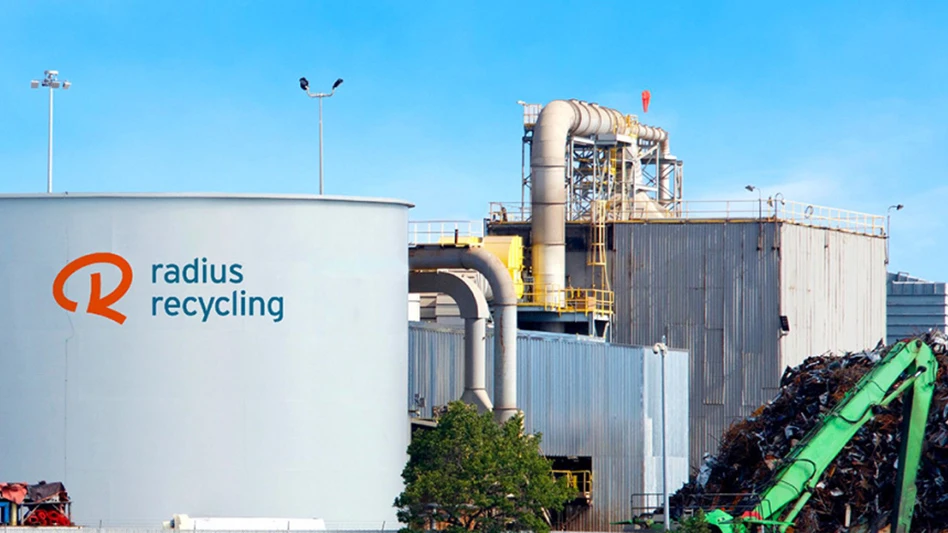
Megan Smalley
Robotics are a hot topic in the recycling industry today as more of these machines are being deployed at material recovery facilities (MRFs) across the world.
“They have really started to go from being a curiosity to being something really here, and that’s exciting,” said Matanya Horowitz, CEO of AMP Robotics, Louisville, Colorado, during the MRF Operations Forum on Oct. 22 in Chicago. “Robotic technology has been around and commonly used in manufacturing, but now we see this technology migrating over to the recycling industry.”
With more MRFs embracing and considering robotic and artificial intelligence (AI) technologies for their facilities, several robotics suppliers gathered during the MRF Operations Forum to share ways robotics work, how AI works and how these tools can and have added value to MRF operations.
Close look at robotics
Robotics used in MRFs have a few key components. David Marcouiller, executive vice president of sales engineering at Machinex, Plessisville, Quebec, described these components like different body parts. He said a robot has eyes that act as a standard camera, not unlike human eyes that can help with quality control applications. He added that the brain of the robot is the AI that is behind it helping it to learn. Then, the arms and hands of the robots are the physical tools used to grab materials off conveyors with grippers, suction cups and air nozzles.
Marcouiller said it’s easiest for MRFs to install robotics on quality control lines “positioned after optical sorters to assist or replace human quality control.” They also can be placed to help with sorting containers. He added that some MRFs are also installing these machines on fiber lines, yet this placement can be challenging in some applications.
Rainer Rehn, chief commercial officer at ZenRobotics Ltd., Helsinki, said MRFs often have the issue of crowded, narrow conveyor belts.
“Very often, conveyors are too narrow,” he said. “Humans have short arms. But robots can reach over wide belts, and you can spread the material then.”
When installing robotics at a MRF, Rehn said it’s important to train the machines as well as the people using them to ensure efficiency. He added that “robots are wonderful, but they are not perfect.” He said some objects are especially difficult to pick and won’t be good applications for robotics, such as rebar.
Close look at AI
Although the terms robotics and AI have sometimes been tossed out interchangeably, Horowitz stressed that these tools aren’t the same thing.
“Robots are the interesting piece you see because that’s the moving part,” he said. “But that’s only one component. There are three systems. Robots get instruction from a vision system, and an AI-powered system will identify objects. A third component is the learning capability of the system.”
Horowitz said AI helps robotics learn to distinguish objects “much like a person.” He said the tool relies on features that serve as visual cues for the robot, such as a Pepsi logo might indicate a PET (polyethylene terephthalate) bottle.
“It’s using combinations of cues to figure things out,” he said. “It can distinguish largely what a person can distinguish. It can handle objects that are difficult that might pile up. [These] systems also open up new doors for problematic packaging” and identify multilayer materials that have typically been challenging for MRFs to sort.
Applying AI and robotics
The waste and recycling industry are turning to robotics and AI as tools to help with sorting. Eric Camirand, founder and CEO of Quebec-based Waste Robotics Inc., said companies want “sorting that is inexpensive, fast and precise.”
He added, “It was said last year at this forum: Quality wins. You need good quality sorting.”
Camirand said one part of quality sorting means training AI and robotics of the changing material streams at MRFs. Packaging resins change over time, and he said it’s important for AI to be aware of those changes in order to achieve better quality with sorting.
In addition, he said MRFs and recyclers can achieve quality sorting with multisensors. Material overlaps on the belt, and robots need to detect objects when they overlap. He added that robots also need to have destacking capability—the ability to move stacked or overlapped material on conveyors. He said that can be done by using multiple robots.
"In order to sort with precision, we can't rely solely on AI," he added. "AI, like humans, will make sorting mistakes in the ever-changing stream of packaging resins. Using multisensor robots helps to diminish these mistakes."
When applying robotics and AI at MRFs, Thomas Brooks, director of technology development at Bulk Handling Systems (BHS), Eugene, Oregon, said operators need to “think about the plant as a whole” and determine what the MRF wants to accomplish by adding these tools.
“Look at what’s the best solution for your facility,” he said.
Sometimes he said AI and robotics will work best when used in tandem with optical sorters.
“We can’t forget opticals,” Brooks said, adding that robotics supplement optical sorters.
Camirand added, “Optical sorting with robotics have the ability to integrate the overall automation process.”
Latest from Recycling Today
- Singapore EAF melt shop idled
- LME reports healthy trading volumes in Q1
- Hyundai adds dealer in Wisconsin
- Study finds recycling symbols largely recognizable
- Reworld announces executive leadership transitions
- Longtime paper industry veteran announces retirement
- Aurubis CEO says its metals play vital role
- Steelmakers await impact of tariff policy







